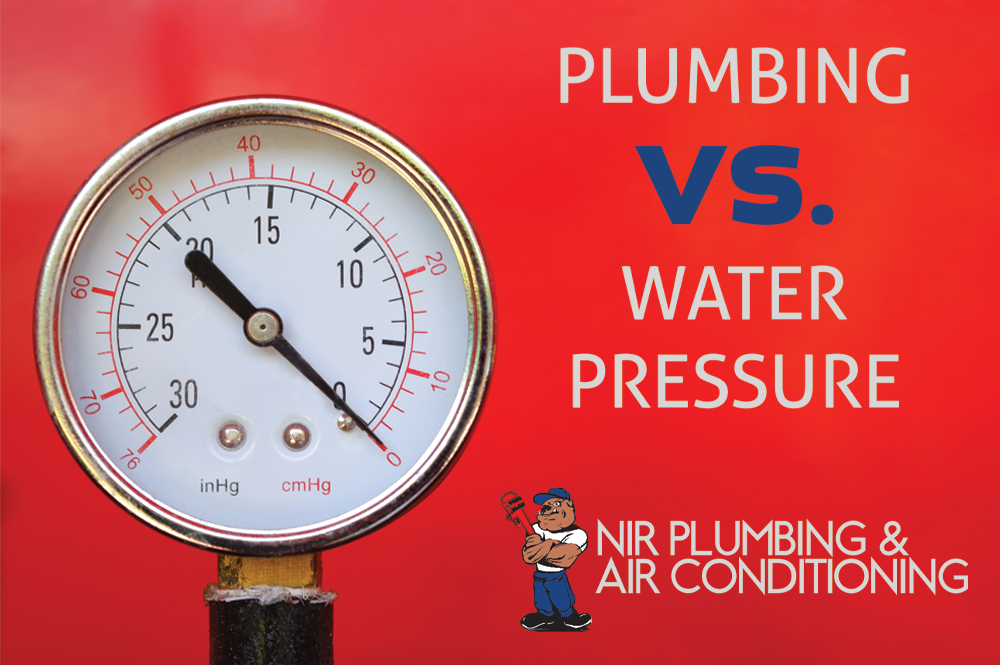[vc_row][vc_column width=”1/1″][vc_column_text]Fun Fact: Water utilities are generally only required to provide above 20 PSI at the meter, and “good” water pressure is usually around 50 PSI to 70 PSI[/vc_column_text][vc_column_text]
It doesn’t matter the reason for wanting to learn how to increase the water pressure in your place. But here’s one good enough reason: The annoyance of hopping into the shower only to experience super low water pressure. It’s like showering with a doll-sized shower head.
Whether you’re on city water or well water, these 5 tips will improve low water pressure:
-
Use a water-pressure gauge to test the pressure
-
Check the shower head for clogs
-
Buy a pressure-reducing valve
-
Reach out to your neighbors
-
Install a water-pressure booster
The fact is that if you wanted low water pressure throughout your home, you would just install miniature appliances. But you didn’t. Because barely anyone wants low water pressure.
So the first thing you want to do (before purchasing larger-than-life appliances) is check the water pressure in your whole house — not just the shower.
The reason you want to find out how the water pressure is in the rest of the house is to help you determine if the pressure is specific to one area, or a bigger area (more area, more problems).[/vc_column_text][vc_column_text]
1. BUY A WATER-PRESSURE GAUGE
[/vc_column_text][vc_column_text]
You can start off by testing the pressure yourself. A water-pressure gauge is as easy as it gets and cost a whopping $9 at a local home improvement retailer. Simply screw the device onto a hose bib like the one on an outdoor faucet and turn on the tap.
TIP: Make sure the rest of your home’s faucets and any water-using appliances (for example, the dishwasher and washing machine) are turned off.
Here’s what the gauge might read when you open the bib’s valve:
-
45 or 50 PSI is on the low side
-
60 PSI is a good reading
-
80 PSI or above is too high
PSI is an abbreviation for pounds per every square inch and is the unit used in measuring water pressure. If the pressure reads between 40 and 60 pounds/PSI, something is restricting the flow of water to your shower. Now that that’s covered…[/vc_column_text][vc_column_text]
2. SEE IF THE SHOWER HEAD IS CLOGGED
[/vc_column_text][vc_column_text]
Don’t we love a good clog removal as plumbers? Your pipes can develop a buildup of mineral deposits over time. In extreme cases, the diameter of the pipes can decrease until they become clogged.
This reduction in size prevents the water from freely flowing through, leaving you with a pitiful drip in the shower or a paltry trickle from the faucet. Here are some things you can do:
Remove the shower head and measure how much water flows out of the shower arm and into a bucket in 10 seconds.
If you collect between 1 1/3 and 1 2/3 gallons of water (equivalent to 8 – 10 gallons per minute) then the head is the culprit. If the flow is less than that, clean or replace the shower valve.
Use a vinegar solution to dissolve clog-causing minerals from the pipes of the shower head
While extreme cases can require that you replace sections of pipe, you can at least take care of clogs at your system’s exit points.
Dissolve any minerals that are gumming up the works by doing the following 4 steps:
-
Place an open zip-lock bag filled with vinegar over your shower head or faucet
-
Tie the bag in place with a rubber band or some string and leave it overnight to soak
-
Rinse off your cleaned fittings the next morning
-
Reassemble your bathroom
— Finito!
If this trick doesn’t work and you believe you have a more severe mineral clog inside the pipes, call in a plumber to assess and correct the problem. (Or continue reading to the next tip because it might help.)[/vc_column_text][vc_column_text]
3. PRESSURE-REDUCING VALVE (FOR THE WHOLE HOUSE)
[/vc_column_text][vc_column_text]
What if the gauge shows that the entire house has low water pressure? Your house has a main water valve that’s usually located near the meter. It controls the flow of water into your home’s pipes. You could try adjusting the pressure-reducing valve.
To find the valve, look at the main supply pipe near your water meter. It’s a conical valve that has a bolt sticking out of the cone. Check to see if it’s completely open.
The valve sometimes gets turned during routine repairs and maintenance. If your drop in pressure coincides with recent work you’ve had done on your home, your contractor may have turned off the main water supply and only partially reopened the valve. The result: restricted flow and reduced pressure.
Fortunately, the valve is easy for you to adjust yourself. To raise pressure, turn the bolt clockwise after loosening its locknut. Keep an eye on the gauge to make sure the pressure is within bounds and retighten the locknut.
If that adjustment doesn’t help, the municipal pressure itself might be inadequate.[/vc_column_text][vc_column_text]
4. TALK TO YOUR NEIGHBORS FOR MORE INSIGHT
[/vc_column_text][vc_column_text]
We’re encouraged to not talk to strangers, and some of just prefer to not talk to anyone if we could help it. But you might need to talk to your neighbors to get a sense of whether they have good water pressure or not. Are they experiencing a similar problem with their water pressure?
If so, the issue may be with the city’s municipal water system. Just like your home’s piping, these systems are subject to leaks, clogs, buildup, and corrosion. So you might need to call the water company to check the shutoff valve out by the street.
If your neighbors’ water pressures are also low, there’s only one thing left to do:[/vc_column_text][vc_column_text]
5. INSTALL A WATER-PRESSURE BOOSTER
[/vc_column_text][vc_column_text]
It may turn out that the problem isn’t you, it’s the neighborhood. (The Monsters Are Due On Maple Street, anyone?) Gravity and distance are two main factors that negatively impact water pressure.
If your household water supply is forced to travel uphill or over a great distance from the municipal water source, its pressure may be hindered.
To increase the flow rate of the water when it reaches your home, consider installing a water pressure booster pump. A water-pressure booster consists of an electric pump that feeds water to a tank that keeps the water at the desired pressure.
The pump runs about $200 or $300 without installation. Is it a bit pricey? Yes.. but isn’t everything in life these days?
We recommend you leave this one to the professionals, as the installation requires wrenches, air compressors, soldering torches, and all types of weirdo plumbing gadgets that sound like tools Jigsaw would use as torture devices in the Saw franchises.
If you are interested in a detailed explanation of how a water-pressure booster is installed, check out this article.
Related article(s): This Old House – How to Increase Water Pressure on City Water; Bob Vila – Water Pressure: 5 Ways to Improve Yours
And if you have low water pressure with a well system, check out this article and this article that talks about signs of contamination in homes with well water.[/vc_column_text][/vc_column][/vc_row]


